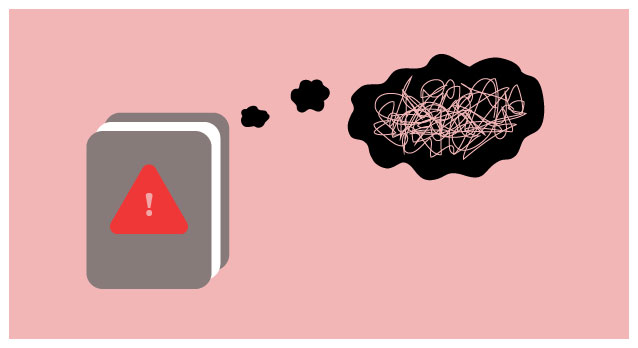Viewer Discretion is Advised: On the Trigger Warning System
While trigger warnings certainly aren’t the only resource survivors are asking for, this system does seem to be an area of intense misunderstanding and controversy. As a way to dissect all of the dialogue surrounding this issue, let’s first start off with the basic Wikipedia definition of a trauma trigger:
“A trauma trigger is an experience that triggers a traumatic memory in someone who has experienced trauma. A trigger is thus a troubling reminder of a traumatic event, […] and can sometimes exacerbate post-traumatic stress disorder (PTSD), a condition in which sufferers cannot control the recurrence of emotional or physical symptoms, or of repressed memory.”
Basically, those who have experienced trauma may be forced to endure flashbacks of such trauma when they are confronted with certain reminders of an attack or violent experience.
Though each individual may be triggered by any number of smells, places, noises, or names, it is somewhat obvious that certain things would affect trauma survivors beyond an individual level. For instance, whereas a specific type of cologne might trigger a survivor whose attacker was wearing the same brand, vivid depictions of rape will probably trigger PTSD in sexual assault survivors on a much larger scale. Therefore, adding a warning to a piece of prose or any classroom material which goes into descriptive detail of violence offers a way for professors to prepare students for a potential flashback and even offers them the opportunity to leave the room in case the specific scene will ignite any PTSD symptoms.
Because one in six men will be assaulted before they reach the age of 18, and one in five women will be assaulted in college, it can be assumed that many university students are affected by sexual trauma.
Therefore student governments around the country (such as the ones at UCSB, Rutger’s University and Oberlin College) have been calling for a university-wide trigger warning system that would be placed on the syllabi of each class and distributed to each student on the first lecture. Because professors already supply a syllabus with grading details, lecture topics, and reading lists to students, the addition of warnings would be simple and would only include adding a line detailing the type of assault (rape, child abuse, incest, etc) and page numbers and/or video minutes of the graphic depictions.
These warnings would not alter the content of the course or censor the material that will be displayed. The warnings are designed to advise a reader with PTSD of the content in the piece so as to avoid setting off a flashback or an outburst at home or in class. This brief informative phrase at the beginning of a syllabi (*trigger warning: child molestation; Page 10-15), does not modify the reading lists or the lecture material in courses. Instead, it simply tells the students about the topics they will be reading before they have the chance to get triggered by it. Thus, students with PTSD can skip the section of the reading with graphic depictions that will trigger them.
Here’s are some common misleading objections to the system and my responses to them:
Trigger warnings impede educational systems because students can opt-out of specific lectures.
College is already an opt-in and opt-out system. No one is required to be there. Students are paying, at UCLA, anywhere between twenty-five thousand and fifty thousand dollars a year, so if something as simple as this warning gives them a reason to skip class, they probably will skip class anyway.
In addition, triggers do not impede survivors’ education. These students already understand because of direct experiences with trauma, so they do not need the lesson in class. For instance, a rape victim would already “get it” without having to witness a graphic depiction of rape in a movie. People are being warned about information not because they have no knowledge of it, or because the information will somehow now be altered, but because these classes can trigger real memories of horrific violence.
Offering a warning before discussing topics of violence simply prepares those who have already experienced such violence for the discussion. Students can then make the decision, based on their own ability to handle flashbacks in public settings, whether or not they want to opt-in/out of a specific lecture.
Trigger warnings are censorship and students should not be allowed to avoid material that might upset them.
Warnings do NOT alter the content of the course and therefore have nothing to do with censorship.
Students are not asking for a warning over potentially offensive courses or material. They are not talking about being offended. A trigger warning allows students to opt out of reading graphic depictions of violence because they have already experienced such violence. It does not censor information, as the students utilizing these resources would already understand without the need to read graphic depictions.
These are not issues that involve simply being “offended.” A trigger warning allows students who may have a flashback in class to avoid being retraumatized by course material.
If we know that one in six men will be assaulted before they reach 18, and one in five women in college will be assaulted, it is safe to assume that a lot of the people in a class could be triggered by these depictions of violence. The content will not be edited. Trigger warnings are simply a request to be warned before they have to witness something they may have just brutally experienced.
Reinforces idea of female weakness; after all, war vets are not asking for trigger warnings and they also have high rates of PTSD.
Survivors are male, female, and gender queer. War veterans are not only male. This argument therefore is not relevant because it assumes that all survivors are female and thereby reinforces false gendered stereotypes about people who have been assaulted.
Also, instead of removing a tool for survivors, why not extend the same tool to war veterans (add a trigger warning for violent war scenes). Instead of upholding unhealthy masculine ideals which associate emotionlessness with strength, why not offer empathy to all those who have experienced violence?
In addition, I would argue that the main reason trigger warnings for assault survivors are being prioritized is because of the sheer amount of survivors who attend university.
Schools are supposed to prepare us for the real world, and students should not be given special accommodation.
Schools are not the “real world.” In fact, they consistently support policies which make them safe places. We have specific bullying and harassment laws in schools that are in place to protect students. This is another policy that will protect students and allow them to opt-out of lectures that might possibly trigger them.
Survivors with PTSD should instead have to register with the university office of students with disabilities and then professors can supply the warnings on an individual basis.
First, how can an individual student request accommodation if they are unaware of the content of the lectures beforehand?
Also, many survivors might not know about this resource or even refuse to sign up because of the stigma around assault.
As a major cause of PTSD that will affect a large portion of the student body, it is more efficient to enforce a campus-wide warning system. Instead of making one in five women and one in six men register, the school could provide these one-sentence warnings as a policy.
Survivors could be triggered by any number of things. How can you provide warnings for any possible trigger?
It is impossible to provide warnings for every trigger, as a specific cologne/perfume or even a name could make someone relieve trauma. That being said, violent depictions/ descriptions of rape are obvious trauma triggers that would affect many.
Preventing every single trigger is impractical. Some people will get triggered by random things such as a specific smell or object; however, the obvious triggers, like graphic depictions of violence and rape, can easily be given a trigger warning.
Trigger warnings can provide accommodation and support for survivors who make up a large portion of the student body.
In terms of survivors’ voices, many have said that these warnings do help. If this system could help even one survivor cope with a traumatic memory of an assault, isn’t it worth it?
In the words of an anonymous PTSD survivor who supports the warnings: “I’m not asking for a special privilege. I’m asking for consideration.”





